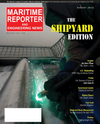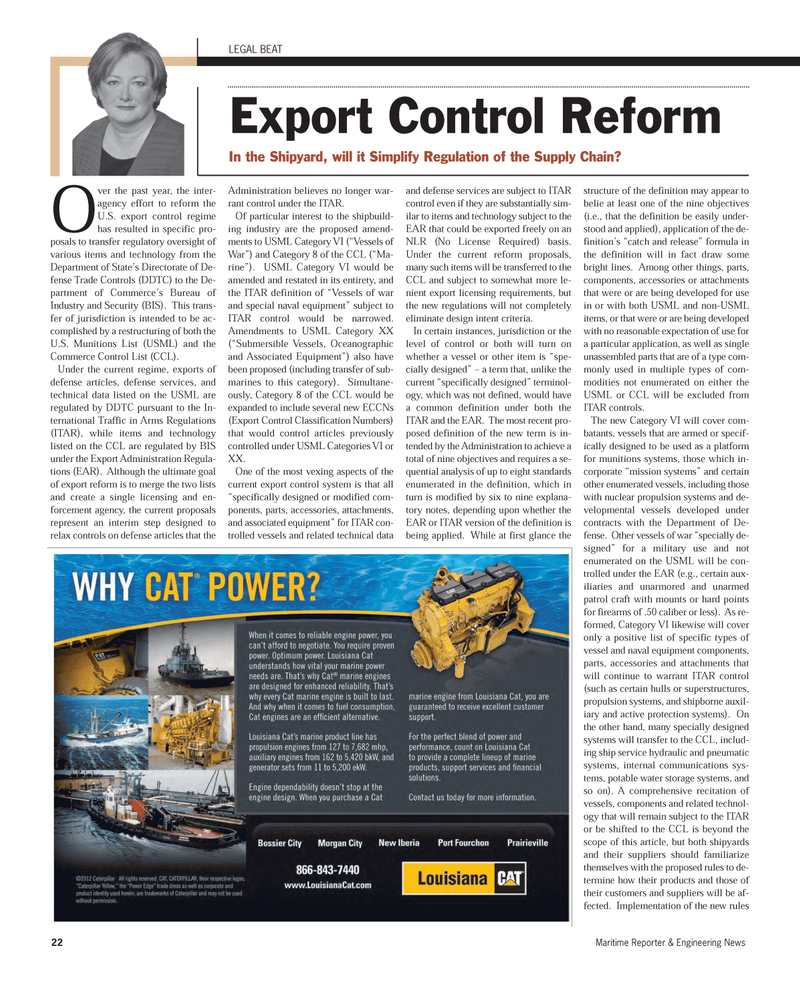
Page 22: of Maritime Reporter Magazine (August 2012)
The Shipyard Edition
Read this page in Pdf, Flash or Html5 edition of August 2012 Maritime Reporter Magazine
22Maritime Reporter & Engineering News LEGAL BEAT Export Control Reform In the Shipyard, will it Simplify Regulation of the Supply Chain? Over the past year, the inter- agency effort to reform the U.S. export control regime has resulted in specific pro- posals to transfer regulatory oversight of various items and technology from the Department of State?s Directorate of De- fense Trade Controls (DDTC) to the De- partment of Commerce?s Bureau of Industry and Security (BIS). This trans- fer of jurisdiction is intended to be ac-complished by a restructuring of both theU.S. Munitions List (USML) and theCommerce Control List (CCL).Under the current regime, exports of defense articles, defense services, andtechnical data listed on the USML areregulated by DDTC pursuant to the In- ternational Traffic in Arms Regulations (ITAR), while items and technology listed on the CCL are regulated by BIS under the Export Administration Regula- tions (EAR). Although the ultimate goal of export reform is to merge the two lists and create a single licensing and en-forcement agency, the current proposals represent an interim step designed torelax controls on defense articles that theAdministration believes no longer war- rant control under the ITAR. Of particular interest to the shipbuild- ing industry are the proposed amend-ments to USML Category VI (?Vessels of War?) and Category 8 of the CCL (?Ma- rine?). USML Category VI would be amended and restated in its entirety, and the ITAR definition of ?Vessels of war and special naval equipment? subject to ITAR control would be narrowed. Amendments to USML Category XX (?Submersible Vessels, Oceanographic and Associated Equipment?) also have been proposed (including transfer of sub-marines to this category). Simultane- ously, Category 8 of the CCL would be expanded to include several new ECCNs (Export Control Classification Numbers) that would control articles previously controlled under USML Categories VI or XX. One of the most vexing aspects of the current export control system is that all ?specifically designed or modified com- ponents, parts, accessories, attachments,and associated equipment? for ITAR con- trolled vessels and related technical data and defense services are subject to ITAR control even if they are substantially sim- ilar to items and technology subject to theEAR that could be exported freely on an NLR (No License Required) basis.Under the current reform proposals,many such items will be transferred to the CCL and subject to somewhat more le- nient export licensing requirements, but the new regulations will not completely eliminate design intent criteria.In certain instances, jurisdiction or thelevel of control or both will turn on whether a vessel or other item is ?spe- cially designed? ? a term that, unlike the current ?specifically designed? terminol- ogy, which was not defined, would have a common definition under both the ITAR and the EAR. The most recent pro- posed definition of the new term is in- tended by the Administration to achieve a total of nine objectives and requires a se- quential analysis of up to eight standardsenumerated in the definition, which in turn is modified by six to nine explana- tory notes, depending upon whether theEAR or ITAR version of the definition is being applied. While at first glance the structure of the definition may appear to belie at least one of the nine objectives (i.e., that the definition be easily under- stood and applied), application of the de-finition?s ?catch and release? formula in the definition will in fact draw some bright lines. Among other things, parts, components, accessories or attachmentsthat were or are being developed for use in or with both USML and non-USMLitems, or that were or are being developed with no reasonable expectation of use for a particular application, as well as singleunassembled parts that are of a type com-monly used in multiple types of com-modities not enumerated on either theUSML or CCL will be excluded from ITAR controls. The new Category VI will cover com- batants, vessels that are armed or specif- ically designed to be used as a platformfor munitions systems, those which in-corporate ?mission systems? and certainother enumerated vessels, including those with nuclear propulsion systems and de-velopmental vessels developed under contracts with the Department of De-fense. Other vessels of war ?specially de- signed? for a military use and notenumerated on the USML will be con-trolled under the EAR (e.g., certain aux-iliaries and unarmored and unarmedpatrol craft with mounts or hard pointsfor firearms of .50 caliber or less). As re- formed, Category VI likewise will cover only a positive list of specific types of vessel and naval equipment components, parts, accessories and attachments thatwill continue to warrant ITAR control (such as certain hulls or superstructures,propulsion systems, and shipborne auxil-iary and active protection systems). On the other hand, many specially designed systems will transfer to the CCL, includ-ing ship service hydraulic and pneumatic systems, internal communications sys-tems, potable water storage systems, and so on). A comprehensive recitation of vessels, components and related technol- ogy that will remain subject to the ITAR or be shifted to the CCL is beyond the scope of this article, but both shipyards and their suppliers should familiarize themselves with the proposed rules to de- termine how their products and those of their customers and suppliers will be af-fected. Implementation of the new rules MR#8 (18-25):MR Template 8/9/2012 3:04 PM Page 22

 21
21

 23
23
